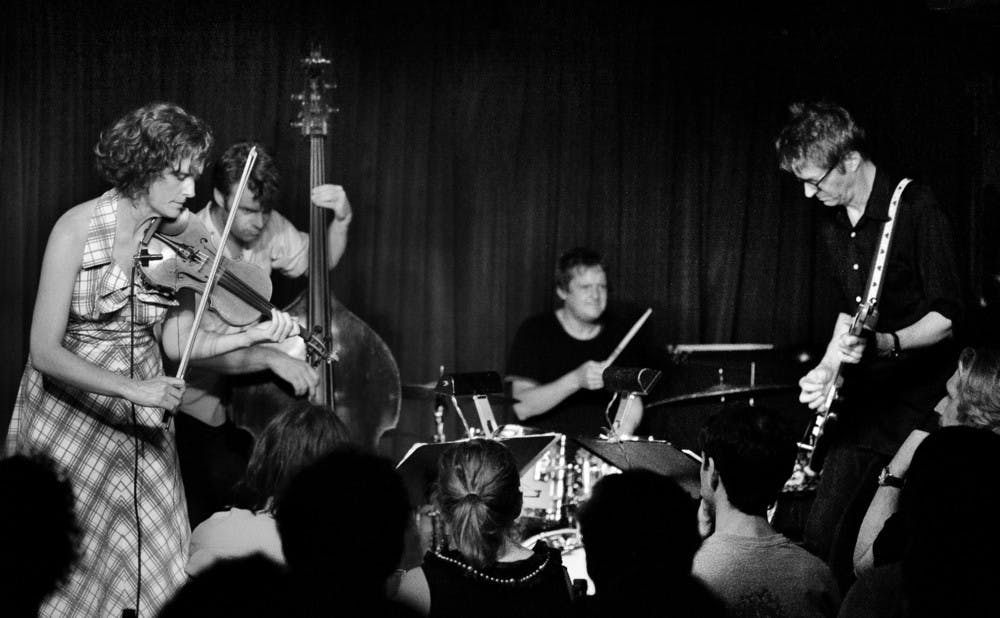In the hectic life of the Duke student, there is little time to sit back and reflect. This Friday, composer, violinist and vocalist Jenny Scheinman will challenge Duke students to do just that in her performance Kannapolis: A Moving Portrait. With her compositions set to filmmaker H. Lee Waters’ works capturing the lives of the people of Kannapolis, NC, Scheinman hopes to showcase the compassionate, affectionate and relatable citizens of the Piedmont in the early 1940s.
When asked about her project, Scheinman explained, “I think it’s probably about human potential for joy in times of hardship. It was shot in the depression; there were various things about that time that were very difficult. The towns were segregated. Things were very not fair. It was a rough time.”
H. Lee Waters was a filmmaker who from 1936 to 1942 went through the states of North Carolina, Virginia, Tennessee and South Carolina filming the local people. He would subsequently play these films at local theaters to allow his subjects to see themselves onscreen. Remarkably, he edited out very little, retaining almost all of the original footage he shot in the final rendition of his project. Today, his works are a sort of time capsule, allowing viewers to partially experience what life was like back then.
“The footage really captures a compassionate aspect of human culture,” said Scheinman. “People are very affectionate with each other. They’re always dancing and performing for the camera… It seems like a culture where the people are very engaged with each other.”
Scheinman will perform her conversations herself, along with Robbie Fulks and Robbie Gjersoe. Jenny will be playing violin and singing. Fulks will be playing guitar and banjo, and contributing to vocals. Gjersoe will sing and play resonator guitar, a louder, more durable variant of guitar that can be seen in a lot of the footage.
The pieces to be set to film are carefully composed such that the music matches the scene cuts. Still, some room is left for improvisation. In some of the instrumental pieces there are sections that repeat over and over, and Steinman described how the band might add small variations as a form of folk improvisation.
In discussing the relationship between the music and the film, Scheinman noted, “There’s a lot of dancing in [the film]. A lot of the music I wrote is dance music, so it almost has the feeling of a musical theater piece or something. There are whole passages where the characters are dancing to our music.”
Finn Taylor was chosen by Scheinman to direct the arrangement of Waters’ films. Taylor has directed three films, one of which, Cherish, was nominated for the Grand Jury Prize at the Sundance Film Festival. Scheinman noted that after she found Taylor to work with her on the project, “things really started moving quickly” and he was invaluable in helping her decide which of her material worked with the footage.
“Music and film is an absolutely magical combination when it clicks,” she observed. “It’s so much more powerful than either of them separately.”
Aaron Greenwald, director of Duke Performances and the one who asked Scheinman to embark on the project five years ago, shares similar sentiments. Greenwald explained that his decision to choose Scheinman came after he watched Waters' films, which “begged for someone who had a knowledge of American folk music and fiddle music.”
“[Jenny Scheinman] has had an interesting and diverse career, as an arranger, jazz improviser, singer, she’s also a really in demand collaborator,” he continued. “I just have a real huge admiration for her. She has a kind of idiosyncratic quality that I really appreciate in an artist.”
Greenwald also hopes the performance will give Duke students a chance to take a break from the cycle of responsibilities that university life might bring.
“I am so struck by how little time there is,” he remarked. "I went to college in the mid nineties and part of what was great was getting to zone out and just listen to music or read a book and think about it. I feel like, increasingly, Duke students, and students everywhere, have less and less time to do that.”
Hopefully, this performance will allow students to reach outside the Duke bubble and reflect on the lives of people who will never directly affect them.
For Scheinman, an important aspect of the footage is a glimpse of a slightly different lifestyle. In her own words: “If there’s wisdom in looking back at a culture before our time it might be to look people in the eye, be affectionate, don’t look at your hand-held device all day. The world they lived in was very different from ours, and very striking.”
Get The Chronicle straight to your inbox
Signup for our weekly newsletter. Cancel at any time.

